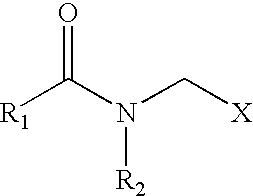Biodegradable anionic acid corrosion inhibitor comprising sarcosines
a corrosion inhibitor and biodegradable anionic acid technology, applied in the direction of wellbore/well accessories, sealing/packing, other domestic objects, etc., can solve the problems of exacerbated corrosion problems, high cost of repairing or replacing corrosion-damaged casings, tubing, etc., to reduce or eliminate the need, reduce surface tension, and efficient hydrocarbon transportation
- Summary
- Abstract
- Description
- Claims
- Application Information
AI Technical Summary
Benefits of technology
Problems solved by technology
Method used
Image
Examples
example 1
[0039]Corrosion tests were performed at 150° F. (65° C.) under atmospheric pressure on 4″×4″ carbon steel (N80) coupons in an agitated water bath. Each metal test coupon was blasted with glass beads before and after the corrosion test to ensure a uniform and clean surface. After the coupons were cleaned and dried, they were weighed before and after the water bath in order to determine the corrosion rate during the test. A 15 wt. % hydrochloric acid solution was applied to the carbon steel for six hours. One comparison run was performed at 150° F. (Sample No. 1 in Table 1) where only the aqueous acidic fluid was used, without any corrosion inhibitor. The surfaces of the test coupons were examined under a microscope for pitting. The results of the corrosion tests are shown in Table 1. The pitting was evaluated using the following pitting scale, which is used for all of the examples described herein:[0040]0=no pitting, staining or surface irregularities;[0041]0−trace=slight staining of...
example 2
[0048]Corrosion tests were performed at 180° F. (82.2° C.) under atmospheric pressure on 4″×4″ carbon steel (N80) coupons in an agitated water bath. Each metal test coupon was blasted with glass beads before and after the corrosion test to ensure a uniform and clean surface. After the coupons were cleaned and dried, they were weighed before and after the water bath in order to determine the corrosion rate during the test. A 15 wt. % hydrochloric acid solution was applied to the carbon steel for six hours. One comparison run was performed at 150° F. (Sample No. 1 in Table 2) where only the aqueous acidic fluid was used, without any corrosion inhibitor. The surfaces of the test coupons were examined under a microscope for pitting. The same pitting scale described in Example 1 was used in Example 2. The results of the corrosion tests for Example 2 are shown in Table 2.
TABLE 2SampleConc.AmountInitial Wt.,Final Wt.,CorrosionNo.Inhibitor(wt. %)Intensifier(lb / 1000 gal)grgrRate, lb / ft2Pitti...
PUM
| Property | Measurement | Unit |
|---|---|---|
| temperatures | aaaaa | aaaaa |
| temperatures | aaaaa | aaaaa |
| temperatures | aaaaa | aaaaa |
Abstract
Description
Claims
Application Information
 Login to View More
Login to View More - R&D
- Intellectual Property
- Life Sciences
- Materials
- Tech Scout
- Unparalleled Data Quality
- Higher Quality Content
- 60% Fewer Hallucinations
Browse by: Latest US Patents, China's latest patents, Technical Efficacy Thesaurus, Application Domain, Technology Topic, Popular Technical Reports.
© 2025 PatSnap. All rights reserved.Legal|Privacy policy|Modern Slavery Act Transparency Statement|Sitemap|About US| Contact US: help@patsnap.com



